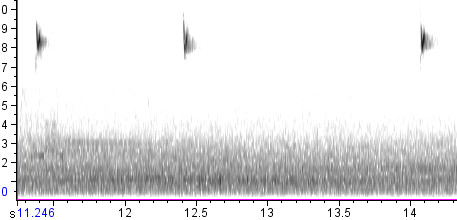Fox Sparrow, Part 2: Alarm & Contact Calls
In my last post I promised a discussion of Fox Sparrow alarm and contact calls, and it’s time to deliver on that promise. Today we’ll look primarily at the calls most frequently heard from Fox Sparrows — the ones given in situations of mild alarm.
“Red” Fox Sparrow
The most common call of the Red Fox Sparrow group is a sharp “stack!” or “smack!” note that is often compared to the alarm calls of Brown Thrasher and Lincoln’s Sparrow:
“Sooty” Fox Sparrow
The common call of the Sooty group is virtually identical to that of the Red group, and individual calls are probably indistinguishable in the field or on the spectrogram. Sooties may tend to call at a faster rate, but it could be that the birds below are simply more agitated:
“Slate-colored” Fox Sparrow
The Slate-colored’s most common call is similar to those of the Red and Sooty groups, but lasts about 50% longer on average, giving it a slightly squeakier quality, somewhat reminiscent of the tennis-shoes-on-a-gym-floor sound of Black-headed Grosbeak’s call, but downslurred instead of upslurred:

The Borror Lab has another excellent online example from Utah. The difference between Slate-colored calls and those of the two prior groups is quite subtle, but distinctive in these examples. There remains some doubt as to whether all Slate-coloreds sound this way, or only the ones in Colorado and Utah. This recording from Washington is labeled as a Slate-colored but sounds more typical of the Sooty group.
“Thick-billed” Fox Sparrow
The call of the Thick-billed group is very unlike the above calls, both spectrographically and to the ear. Often compared with the calls of California Towhee and White-crowned Sparrow, it is a high-pitched, musical “tink” note:
Listen to other examples online at the Borror Lab [1] and the Macaulay Library [1 2].
Agitated “tsip” calls
Identifying a Thick-billed Fox Sparrow by call would be a cinch, but for one inconvenient fact: Fox Sparrows of all four groups make high-pitched repeated “tsip” notes when agitated. Here are some agitated “tsips” from a Slate-colored Fox Sparrow:

Joseph Blacquiere recorded these “tsip” notes from Red Fox Sparrows during his 1979 master’s thesis work, and the Macaulay Library has a recording of similar notes from a Thick-billed Fox Sparrow on a still-undigitized recording. It’s highly likely that Sooty Fox Sparrows also give these calls. The Slate-colored bird that I recorded mixed these “tsips” with the standard alarm calls during its initial excited reponse to playback of its own song, before beginning to respond with song strophes. Blacquiere heard the “tsip” calls from Red Fox Sparrows on fewer than 10 occasions, always from males in extreme agitation.
The “tsip” calls are spectrographically distinct from the “tink” calls of Thick-billed Fox Sparrows, but can be quite difficult to distinguish by ear. Some caution is therefore warranted when identifying Thick-billed Fox Sparrows by their “tink” calls — other Fox Sparrows can sound similar when agitated.